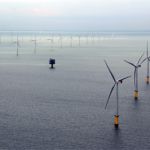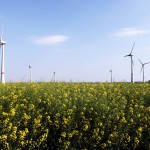
The London Array, located in the Thames Estuary
The world’s largest offshore wind farm was opened last week in the Thames Estuary.
British Prime Minister David Cameron was among the dignitaries present at the inauguration of the 630 MW London Array last week.
Enthusiastically endorsing the first phase of the London Array, Cameron said the massive offshore wind farm represented a major win for renewable energy.
continue reading »
 Comments Off on British Prime Minister celebrates the world’s largest offshore wind farm
Comments Off on British Prime Minister celebrates the world’s largest offshore wind farm

Steve Sawyer of GWEC
At the end of 2012, Brazil had 2.5 GW of installed wind capacity, enough to power four million households, accounting for 2% of national electricity consumption. In 2012 alone, 40 new wind farms came online, adding more than 1 GW of new capacity to the Brazilian electricity grid and creating 15,000 new jobs. This represents an investment of USD 3.43 billion (€2.63 billion), which is expected to increase to USD 24.50 billion (€18.8 billion) by 2020. Steve Sawyer of the Global Wind Energy Council gives his opinion on wind energy in Brazil, the “country of the future”.
How would you compare the current status of the Brazilian wind market to how it was five years ago?
Five years ago, Brazil’s wind industry was in its infancy, with a cap of just 1100 (later 1400 MW) of wind power development. Since the introduction of the auction scheme in 2009, the industry has taken off in a big way.
Why is the Brazilian wind energy auction system successful?
continue reading »

The European Parliament
On their second time around, European MEP’s yesterday voted in favour of ‘backloading’. This means that the number of permits to pollute released under the Emissions Trading System (ETS) will be temporarily reduced by 900 million tonnes of carbon. This will increase the cost of carbon to industry and create an incentive to pollute less. The vote will also “build confidence in the ETS” said Rémi Gruet, the European Wind Energy Association’s (EWEA) Senior Regulatory Affairs Advisor.
The cost of carbon to polluters recently slumped to an all-time low, threatening the relevance of the world’s biggest carbon market. Prices had lost more than 70% in the past four years. Worsened by the economic crisis, the over-supply of permits reached 2 billion metric tonnes in 2012, equal to the EU’s annual limit imposed on 12,000 power plants and factories.
continue reading »
 Comments Off on ETS backloading cautiously welcomed as first step towards reviving carbon market
Comments Off on ETS backloading cautiously welcomed as first step towards reviving carbon market

IEA Executive Director Maria van der Hoeven
A new report from the International Energy Agency (IEA), stating that global power generation from hydro, wind, solar and other renewable sources will exceed that of gas and be twice that of nuclear by 2016, is receiving widespread news coverage.
Renewable power is expected to increase by 40% in the next five years, according to the IEA’s second annual Medium-Term Renewable Energy Market Report launched last Wednesday in New York.
According to the report, renewables are now the fastest-growing power generation sector and will make up almost a quarter of the global power mix by 2018, up from an estimated 20% in 2011.
In addition, the report found that the share of non-hydro sources such as wind, solar, bioenergy and geothermal in total power generation will double, reaching 8% by 2018, up from 4% in 2011 and just 2% in 2006.
“As their costs continue to fall, renewable power sources are increasingly standing on their own merits versus new fossil-fuel generation,” IEA Executive Director Maria van der Hoeven said as she presented the report at the Renewable Energy Finance Forum.
continue reading »
 Wallonia, the French-speaking part of Belgium, is considering placing wind turbines along its motorways to meet its ambitious renewable energy targets, Carlo Di Antonio, the Belgian minister of public works has announced.
Wallonia, the French-speaking part of Belgium, is considering placing wind turbines along its motorways to meet its ambitious renewable energy targets, Carlo Di Antonio, the Belgian minister of public works has announced.
The minister told Belgian radio at the end of June that he planned to come forward with a plan “in a few weeks” that will show how wind turbines can be placed “almost exclusively” along motorways and their service roads.
The plan is expected to show how a combination of large turbines of around 350 kw and medium turbines of 30-350 kw could meet Wallonia’s target of producing 4,500 GWh a year of electricity from wind by 2020. This target is a considerable increase from the 1,200 GWh generated by wind in the country today.
At the end of February, the government of Wallonia took the first steps to give greater certainty to the development of future wind turbines, when it finally agreed a new regulatory framework for the sector. It also published a draft map showing the areas in the region most likely to produce the most wind power.
continue reading »
 Comments Off on Belgian motorways to become wind energy corridors
Comments Off on Belgian motorways to become wind energy corridors












